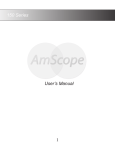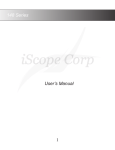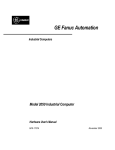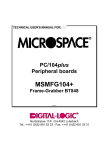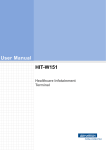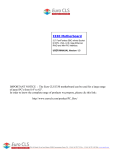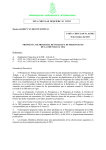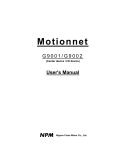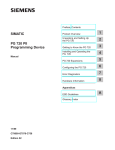Download Marathon Series Industrial Computers and Monitors User`s Manual
Transcript
GE Fanuc Automation Industrial Computer Products Marathon Series Industrial Computers and Monitors User's Manual GFK-1791A April 2001 GFL-002 Warnings, Cautions, and Notes as Used in this Publication Warning Warning notices are used in this publication to emphasize that hazardous voltages, currents, temperatures, or other conditions that could cause personal injury exist in this equipment or may be associated with its use. In situations where inattention could cause either personal injury or damage to equipment, a Warning notice is used. Caution Caution notices are used where equipment might be damaged if care is not taken. Note: Notes merely call attention to information that is especially significant to understanding and operating the equipment. This document is based on information available at the time of its publication. While efforts have been made to be accurate, the information contained herein does not purport to cover all details or variations in hardware or software, nor to provide for every possible contingency in connection with installation, operation, or maintenance. Features may be described herein which are not present in all hardware and software systems. GE Fanuc Automation assumes no obligation of notice to holders of this document with respect to changes subsequently made. GE Fanuc Automation makes no representation or warranty, expressed, implied, or statutory with respect to, and assumes no responsibility for the accuracy, completeness, sufficiency, or usefulness of the information contained herein. No warranties of merchantability or fitness for purpose shall apply. The following are trademarks of GE Fanuc Automation North America, Inc. Alarm Master CIMPLICITY CIMPLICITY 90–ADS CIMSTAR Field Control GEnet Genius Helpmate Logicmaster Modelmaster Motion Mate ProLoop PROMACRO PowerMotion PowerTRAC Series 90 Series Five Series One Series Six Series Three VersaMax VersaPro VuMaster Workmaster ©Copyright 2000—2001 GE Fanuc Automation North America, Inc. All Rights Reserved. Contents Chapter 1 Product Features ............................................................................................. 1-1 Innovative Modular Design .................................................................................... 1-1 Factory Ready ........................................................................................................ 1-2 Connectivity........................................................................................................... 1-2 Marathon Display Modules........................................................................................... 1-3 Features.................................................................................................................. 1-3 Modular Simplicity................................................................................................. 1-3 Rugged Touchscreens............................................................................................. 1-4 Keypad Option ....................................................................................................... 1-4 Marathon Series CPU Module, Standard....................................................................... 1-5 Marathon Series CPU Module, Expanded ..................................................................... 1-6 Single Board Computers ............................................................................................... 1-7 SBC-Max-2 Features .............................................................................................. 1-7 SBC-PII Features.................................................................................................... 1-7 SBC-PII Single Board Computer Overview ............................................................ 1-8 SBC-PII Detailed Feature Description .................................................................... 1-8 Marathon Series Monitor Video Electronics Module................................................... 1-10 Chapter 2 Marathon Monitors — Quick Install.............................................................. 2-1 Installing Marathon Display Modules ........................................................................... 2-1 Installing the Marathon Monitor Video Electronics Module .......................................... 2-2 Connecting the Marathon Video Electronics Module .............................................. 2-2 Setting Video Resolution ........................................................................................ 2-3 Switch Box Installation........................................................................................... 2-4 Installing the Dynapro SC3 Driver ................................................................................ 2-5 Calibrating the Dynapro SC3 Driver ............................................................................. 2-5 Monitor Adjustments .................................................................................................... 2-6 Display Control Menus........................................................................................... 2-6 Remove On Screen Display .................................................................................... 2-7 Video Position Adjustment ..................................................................................... 2-7 Width ..................................................................................................................... 2-7 Brightness .............................................................................................................. 2-7 Contrast.................................................................................................................. 2-8 Phase...................................................................................................................... 2-8 Zoom Enable.......................................................................................................... 2-8 Restore Factory Settings ......................................................................................... 2-8 Video Source.......................................................................................................... 2-8 Menu Position Adjustment ..................................................................................... 2-9 Menu Timeout........................................................................................................ 2-9 Status ..................................................................................................................... 2-9 GFK-1791A iii Contents Chapter 3 Marathon Computers — Quick Install .......................................................... 3-1 Installing Marathon Display Modules ........................................................................... 3-1 Installing Marathon Computer (CPU) Modules ............................................................. 3-2 Power Connections ....................................................................................................... 3-3 Powering Up the Marathon Unit ................................................................................... 3-3 Setting Up Windows 98 Systems .................................................................................. 3-4 Setting Up Windows NT Systems ................................................................................. 3-4 Setting Screen Resolution ............................................................................................. 3-5 Calibrating the Touchscreen.......................................................................................... 3-6 Configuring the Marathon Computer to Run on a Microsoft Network............................ 3-6 Login Recommendation................................................................................................ 3-6 Chapter 4 Keypad and Connector Information .............................................................. 4-1 Keypads ....................................................................................................................... 4-1 Marathon 12" Display Keypad Assignments ........................................................... 4-2 Marathon 15" Display Keypad Assignments ........................................................... 4-3 Connectors ................................................................................................................... 4-5 Front Access Panel ................................................................................................. 4-5 Communication Ports ............................................................................................. 4-5 ISA and PCI Expansion on the Marathon MSCPX CPUs .............................................. 4-6 Chapter 5 BIOS Setup Guide........................................................................................... 5-1 Starting the BIOS Setup Utility..................................................................................... 5-2 Navigating the Setup Menus ......................................................................................... 5-2 Legend Bar............................................................................................................. 5-3 Field Help Window ................................................................................................ 5-3 General Help Window ............................................................................................ 5-4 Main Menu ................................................................................................................... 5-5 Advanced Hard Disk Features....................................................................................... 5-6 Advanced Menu............................................................................................................ 5-7 Integrated Peripherals ............................................................................................. 5-8 Security Control ................................................................................................... 5-11 Power Menu ............................................................................................................... 5-12 Boot Menu.................................................................................................................. 5-14 Exit Menu................................................................................................................... 5-15 Exit Saving Changes............................................................................................. 5-15 Exit Discarding Changes ...................................................................................... 5-15 Load Setup Defaults ............................................................................................. 5-16 Discard Changes................................................................................................... 5-16 Save Changes ....................................................................................................... 5-16 iv Marathon Series Industrial Computers and Monitors User's Manual–April 2001 GFK-1791A Contents Chapter 6 Technical Specifications .................................................................................. 6-1 CPU ............................................................................................................................. 6-1 Displays ....................................................................................................................... 6-1 Touchscreens................................................................................................................ 6-2 System DRAM ............................................................................................................. 6-2 System DRAM Installation (U3)................................................................................... 6-2 Connectors ................................................................................................................... 6-3 SBC-Max-2 Single Board Computer Connectors .................................................... 6-3 PS/2 Mouse........................................................................................................... 6-3 Keyboard Connector ............................................................................................. 6-3 USB Ports............................................................................................................. 6-4 Serial Port Connector ............................................................................................ 6-4 Printer Port (LPT1) ............................................................................................... 6-4 VGA Video Connector.......................................................................................... 6-5 Ethernet Port (E-NET) .......................................................................................... 6-5 SBC-PII Single Board Computer Connectors.......................................................... 6-6 External Battery (J14) ........................................................................................... 6-6 PS/2 Mouse Connector (J17)................................................................................. 6-6 Keyboard Interface (J27)....................................................................................... 6-6 USB Ports (J21) .................................................................................................... 6-8 Serial Port Interface (J18, J19, J24 and J25)........................................................... 6-9 Serial Port Information........................................................................................ 6-10 SF12 Definition .................................................................................................. 6-10 Parallel Port (J20) ............................................................................................... 6-11 VGA Video Connector........................................................................................ 6-11 Ethernet (J10) ..................................................................................................... 6-12 Ethernet LEDs (J9) ............................................................................................. 6-12 Interrupt Assignments................................................................................................. 6-13 Chapter 7 Dimensions....................................................................................................... 7-1 12" Display, No Keypads, Standard Back CPU or Monitor Video Electronics Module7-2 12" Display, Keypads, Standard Back CPU or Monitor Video Electronics Module.. 7-3 12" Display, No Keypads, Expanded Back CPU ..................................................... 7-4 12" Display, Keypads, Expanded Back CPU........................................................... 7-5 15" Display, No Keypads, Standard Back CPU or Monitor Video Electronics Module7-6 15" Display, Keypads, Standard Back CPU or Monitor Video Electronics Module.. 7-7 15" Display, No Keypads, Expanded Back CPU ..................................................... 7-8 15" Display, Keypads, Expanded Back CPU........................................................... 7-9 18" Display, No Keypads, Standard Back CPU or Monitor Video Electronics Module7-10 18" Display, No Keypads, Expanded Back CPU ................................................... 7-11 GFK-1791A Contents v Chapter Product Features 1 A Marathon computer, with a PentiumTM, AMDTM, CeleronTM, or PIIITM processor, combined with one of the many Marathon display options, can run virtually any application efficiently, crunching through even the most complex algorithms at amazing speeds. State-of-the-art panel mounting and connecting systems make it perfect for the shop floor or control area. Built for harsh environments, a Marathon flat-panel computer will give you many years of trouble-free service. Flexible and robust, Marathon computers make it easy for operators to monitor and interact with machines and industrial processes. They give you the features you need and connectivity that’s second to none. Because they’re open-system machines, they’ll easily expand with your business. Available in a full range of sizes, Marathon Flat Panel Displays offer an array of features and options to complement their superior resolution and wide-angle visibility. Durable and sensitive analog resistive touchscreens, and optional integrated membrane keypads increase the adaptability of Marathon industrial monitors to your needs. Innovative Modular Design Marathon computers and monitors incorporate a unique modular design for quick installation that dramatically reduces your downtime. You can connect the CPU module or Monitor Video Electronics module to a Marathon Display package simply and easily. Because Marathon series CPU modules work automatically with any size display, you can greatly reduce your spare parts inventory costs. The modular design also allows for fast and easy future upgrades. The following drawing shows a Marathon Display with a CPU module attached. Marathon Display A I F1 F9 B J C K D L E M F N G O H P F2 F10 F3 F11 F4 F12 F5 F13 F6 F14 F7 F15 F8 F16 del hom e ctr l ta b pr int en d alt + - 1 4 * / 7 up shift spa ce pa ge shift lock Marathon CPU Module or Monitor Video Electronics Module esc bac k spa ce dow n enter = Q R S T 2U 5 3V 6 8 9 . W Z X 0 Y marathon series GFK-1791A 1-1 1 Factory Ready Designed and built to withstand harsh, demanding environments, Marathon monitors are the perfect tools for delivering information on the factory floor. • Substantially smaller in size, they fit easier in any location • Modular design allows for speedy installation and removal • Increased reliability reduces downtime in your factory • Lower power consumption rate means reduced operating costs and lower temperature • Immunity to electromagnetic emissions, resistance to vibration, and a wider operational temperature range enhance flexibility of placement Connectivity A Marathon series industrial computer is the ideal choice for plant floor communications. The CPU module contains on-board Ethernet (10/100 Mbps), dual USB (Universal Serial Bus) ports, dual RS-232 COM ports (one used by touchscreen) and an IrDA port so that you can connect without the need for additional hardware. 1-2 Marathon Series Industrial Computers and Monitors User's Manual – April 2001 GFK-1791A 1 Marathon Display Modules Combine a 12.1", 15", or 18.1" Marathon Display module with a CPU module to create an industrial computer package. Combine a 12.1" or 15" Marathon Display module with a Monitor Video Electronics module for a stand-alone industrial monitor. The Marathon Display module is installed in the panel cutout with clips. The CPU module and the Monitor Video Electronics module are installed on the Marathon Display module using clamps. The following drawing shows a Marathon Display Module with a Monitor Video Electronics module. The Video Electronics module has the same dimensions as the MSCPU computer module. Panel Marathon Display A I F1 F9 B J C K D L E M F N G O H P F2 F3 F11 F12 F4 F13 F5 F14 F6 F15 F7 F16 F8 home ctrl end alt del tab print up shift space page shift lock Marathon Monitor Video Electronics Module F10 esc back space enter down + * / Q 1 R 2 T 4 W 7 V 6 X 8 Z = S 3 U 5 0 Y 9 . marathon series Features Displays High Performance High Visibility 12.1" SVGA 800 x 600 pixels 15.0" XGA 1024 x 768 pixels 18.1" SXGA 1280 x 1024 pixels Direct CRT replacement Compatible with VESA compliant video signals Analog Resistive touchscreen with serial output Auto-sizing Standard 15 pin VGA input Optional function keypad Front or side-accessible keyboard port TFT Active Matrix Color Modular Simplicity Unlike systems that require a specific PC bus video card, Marathon series flat-panel monitors with state-of-the-art technology connect directly to your video sources using standard DB15 connectors. This makes connecting our flat-panel monitors to such non-PC compatible platforms as VMEbus or GFK-1791A Chapter 1 Product Features 1-3 1 Macintosh easy. For even greater convenience, you don't need a drill or screws to mount a Marathon monitor in a panel—it simply clips in place. Rugged Touchscreens All Marathon displays come with a resistive touchscreen. Offering excellent durability and resolution, resistive technology can be used in a wide variety of applications and environments. All touchscreen Marathon series monitors come with high performance device drivers that enable the touchscreen to emulate a mouse. They can operate with any application designed to run under Windows™ 95/98, Windows NT™, or Windows 2000™. Resistive touchscreens allow operation with gloved hands. Keypad Option The 12" and 15" Marathon Displays are available with integrated membrane keypads, making them even more adaptable to your demanding applications. The membrane keypad option is not available with the 18" Marathon display. 1-4 Marathon Series Industrial Computers and Monitors User's Manual – April 2001 GFK-1791A 1 Marathon Series CPU Module, Standard The Standard CPU module contains a powerful CPU and all the support functions required for a tough, industrial computer. The module can be connected to any of the Marathon displays, and is easily attached or removed for maintenance. Marathon Display A I F1 F9 B J C K F2 F10 F3 D L E M F N G O H P F4 F12 F5 F13 F6 F14 F7 F15 F8 F16 ho me ctr l en d alt de l ta b pri nt up spa ce shift pa ge shift lock Standard CPU Module F11 esc ba ck spa ce do wn enter + * / Q 1 R 2 T 4 3 U 5 W 7 8 Z = 0 S V 6 X Y 9 . marathon s eries Monitor Package Standard CPU Module GFK-1791A Chapter 1 Product Features 1-5 1 Marathon Series CPU Module, Expanded The Expanded CPU module has the same features as the Standard CPU module with the addition of two ISA expansion slots, two shared PCI/ISA expansion slots, and a CD-ROM. The module can be connected to any of the Marathon displays, and is easily attached or removed for maintenance. Marathon Display A I F1 F9 B J C K F2 F11 D L F4 F12 E M F N G O H P F13 F5 F6 F14 F7 F15 F8 F16 home ctrl end alt del tab print up space shift page shift lock Expanded CPU Module F10 F3 esc back space down enter + * / Q 1 R 2 T 4 7 = Z S 3 U 5 W V 6 X 8 0 Y 9 . marathon series Marathon Display Expanded CPU Module 1-6 Marathon Series Industrial Computers and Monitors User's Manual – April 2001 GFK-1791A 1 Single Board Computers SBC-Max-2 Features Processor Pentium MMX or AMD-K6-2 Memory BIOS 64 MB, 128 MB Phoenix L2 Cache 512K Drives 4GB or greater IDE hard drive 1.44 MB floppy, front accessible Windows 98 or Windows NT Screen Drivers Ports 10/100 Base-T Ethernet (RJ-45) Two USB Two RS-232 serial ports (One used for touchscreen) One Parallel, DB-25 Centronix compatible One VGA, DB-15 output One IrDA, Full Duplex One PS/2 Keyboard port, front or side access One PS/2 Mouse port, front or side access Operating Systems Power Supply Windows 98, Windows NT, or Windows 2000 110-240VAC, 50-60Hz, 100W (@ 50°C supply only) SBC-PII Features Processor Memory Expansion Slots Celeron or PIII 64 MB, 128 MB, or 256 MB Two ISA, two shared PCI/ISA BIOS Phoenix BIOS L2 Cache Drives 512KB (Celeron 128KB) 4GB or greater IDE hard drive 1.44 MB floppy, front accessible CD-ROM, front accessible, R/W CD-ROM available with PIII processors Screen Drivers Ports Windows 98, Windows NT, or Windows 2000 10/100 Base-T Ethernet (RJ-45) Two USB Two RS-232 serial ports (one used for touchscreen) One parallel, DB-25 Centronix compatible One VGA, DB-15 output One IrDA, Full Duplex One PS/2 Keyboard port, front or side access One PS/2 Mouse port, front or side access Windows 98, Windows NT, or Windows 2000 Operating Systems Power Supply GFK-1791A Chapter 1 Product Features 110-240VAC, 50-60Hz, 100W (@ 50°C supply only) 1-7 1 SBC-PII Single Board Computer Overview The SBC-PII is an industrial-design single board computer with all the functionality of today’s best desktop Intel Celeron and PIII machines. Its standard features include a Celeron or PIII CPU, Accelerated Graphics Port (AGP) video controller, 10/100BaseT Ethernet, and USB ports. The SBC-PII provides leading edge flat panel support, including GUI Accelerator and Multimedia Engine especially for the newer color TFT LCDs. This 64-bit AGP chip includes up to 4Mbytes SDRAM video memory for maximum color depth in all resolutions and operating systems. The CT69000 also supports YUV and NTSC input with RGB conversion for CRT and provides display centering and stretching features for optimal presentation of VGA graphics and text on 800x600 and 1024x768 panels. The SBC-PII memory and storage options start with 8Mbytes DRAM and up to 256 Mbytes with one double sided non-registered DIMM. The IDE hard disk interface supports up to four IDE (ATA/ATAPI) drives. The floppy disk controller supports two 1.44Mbyte or 2.88Mbyte floppy drives. Other I/O features include two USB ports for extra peripheral interfaces, up to four serial ports (one with IrDA interface), slot or header option, a printer port, plus standard keyboard header, PS/2 mouse and PC speaker. Advanced power management with timed power down, wake-up on LAN, PS/2 mouse or Keyboard triggers. Completing the list of features is PCI/ISA bus expansion using a PISA option card. SBC-PII Detailed Feature Description Processor Intel PIII available with 700MHz or above core frequencies with 512KB level two cache or Intel Celeron with 566MHz or above core frequencies with 128 KB level-two cache. Binary compatible with applications running on previous members of the Intel microprocessor line DRAM controller SDRAM from 8 to 128 Mbytes or 256 Mbytes (with non-registered DIMMs) Up to one double-sided DIMM (2 rows memory) PCI bus interface Power Management Functions PCI Rev. 2.1, 3.3V and 5V, 33MHz interface compliant Stop Clock Grant and Halt special cycle translation (host to PCI Bus) Dynamic power down of idle SDRAM rows Independent, internal dynamic clock gating reduces average power dissipation DPMS for CRT power-down (required for support of EPA Energy-Star program) DDC for CRT Plug-Play & Display Control Supports LAN, PS/2 or keyboard wake up functions Independent Timing of Up to 4 Drives Front Panel Connector providing access to hardware Reset and IDE activity LED Integrated IDE Controller Enhanced DMA Controller System Timer, Refresh Request, Speaker Tone Output USB Two USB Ports for Serial Transfers at 1.5 or 12 Mbit/sec per UHCI Revision 1.1 SMBus Host interface Allows CPU to Communicate via SMBus Slave Interface Allows External SMBus Master to Control Resume Events 1-8 Marathon Series Industrial Computers and Monitors User's Manual – April 2001 GFK-1791A 1 Real-Time Clock Multimedia Flat Panel/CRT GUI Accelerator Super I/O GFK-1791A 256-Byte Battery-Back CMOS SRAM Highly integrated design Flat Panel and CRT GUI Accelerator & Multimedia Engine, Palette/DAC, and Clock Synthesizer Hardware Windows Acceleration — Transparent System-to-Screen and Screen-to-Screen BitBLT — 8/16/24 Color Expansion — Optimized for Windows BitBLT format High Performance deep write buffers 170 MHz RAMDAC Hardware Multimedia Support — YUV input from System Bus or Video Port — Capture / Scaling, Video Zoom up to 8x Display centering and stretching features for optimal fit of VGA graphics and text on 800x600 and 1024x768 panels Optimized for High-Performance Flat Panel Display at 3.3V and 5V — 640 x 480 x 24bpp to 1280 x 1024 x 24bpp Flexible On-chip Activity Timer facilitates ordered shutdown of the display system Fully Compatible with IBM VGA PC97 compliant hardware 2.88MB floppy disk controller, supports two 360K / 720K / 1.2M / 1.44M/2.88M floppy disk drives Multi-mode high performance parallel port Serial ports – four 16C550 compatible, enhanced RS-232 ports, support SIR or ASKIR IrDA Keyboard Controller — Standard keyboard and PS/2 mouse Ethernet Supports 10 Mb/s and 100 Mb/s N-way auto-negotiation Supports Full duplex flow control (IEEE 802.3x) LED interface for network activity indications PC Expansion Monitoring Supports PCI - ISA expansion board Fan Monitor Power Supply Monitor Flash drive Disk on a Chip — Up to 144Mbytes Compact Flash/ATA Chapter 1 Product Features 1-9 1 Marathon Series Monitor Video Electronics Module Add the Marathon Monitor Video Electronics Module to a Display package for a stand-alone industrial monitor. The following drawing shows a Marathon Product configured as a stand-alone industrial monitor. The MSMON-00 Video Electronics package is used with 12.1", and 15" displays. Panel Marathon Display A I B J F1 F9 F2 C K D L F3 F11 F12 F4 E M F N G O H P F13 F5 F14 F6 F15 F7 F16 F8 home ctrl end alt del tab print up shift space page shift lock Marathon Monitor Video Electronics Module F10 esc back space down enter + * / Q 1 R 2 T 4 7 V 6 X 8 Z = S 3 U 5 W 0 Y 9 . marathon series 1-10 Marathon Series Industrial Computers and Monitors User's Manual – April 2001 GFK-1791A Chapter Marathon Monitors — Quick Install 2 A Marathon Industrial Monitor consists of two components: a Marathon display, and a Marathon Monitor Video Electronics module. The installation process is simple. Make a cutout in the panel, clip the Display module in place, then attach the Marathon Monitor Video Electronics module to the display package using the built-in quarter-turn clamps. If you have questions during the installation process you can contact our technical support group at 1-800-433-2682. All Marathon Industrial Monitor products are fully compatible with VESA compliant Video signals. Installing Marathon Display Modules Each Marathon Display is assigned a model number, based on the display size and whether it has the optional keypad. MSDIS-1200 MSDIS-1210 MSDIS-1500 MSDIS-1510 12.1" SVGA, Touchscreen 12.1" SVGA, with Keypads and Touchscreen 15.0" XGA, Touchscreen 15.0" XGA, with Keypads and Touchscreen To determine the correct panel cutout, note the model number on your display and match the dimension drawing in chapter 7 of this manual with your display. Copy the panel cutout dimensions to your panel and mark the panel cutout hole. After cutting the hole, insert the display in the cutout and attach the mounting clips to the notches along the sides of the display housing. Tighten the clips and you are done with the display installation. Mounting Clips GFK-1791A 2-1 2 Installing the Marathon Monitor Video Electronics Module The next step in the installation of a Marathon Industrial Monitor is to mount the Monitor Video Electronics module to the back of the display module. The MSMON-00 Monitor Video Electronics module is used with 12.1", and 15" displays. Align the Marathon Monitor Video Electronics Module with the opening in the back of the display module. Four mounting clamps are used to secure the video package to the display package. Turn the screws in the mounting clamps to secure. Panel Mounting Clamps Connecting the Marathon Video Electronics Module 1. Connect a VGA Cable from your computer to the Marathon Video Electronics Module Video port. The following drawing shows the connector panel on the Marathon Video Electronics Module. KYBRD OUT VIDEO COM SWITCHES KYBRD IN 2-2 2. If you are using the touchscreen, connect the serial port from your computer to the COM port on the Marathon Video Electronics Module and load the touchscreen driver on your computer using the provided Touchscreen driver disk. Refer to “Dynapro SC3 Driver Installation.” You will need to calibrate the touchscreen after driver installation. For calibration refer to “Calibrating Dynapro SC3 Drivers.” 3. If you are using a Keypad or external keyboard you must connect the keyboard port from your computer to the KYBRD OUT port on the Marathon Video Electronics Module. Marathon Series Industrial Computers and Monitors User's Manual – April 2001 GFK-1791A 2 4. Connect your keyboard (if used) to either the front-access PS/2 port on the front of your marathon display or to the KYBRD IN port on the Marathon Video Electronics module. Both the front access port and the side access keyboard ports may not be used simultaneously. 5. Connect power. Power connections are made to a terminal strip located on the side of the unit. To access the terminal strip, remove the rear cover. The power supply is rated at 110 240VAC, 50 - 60Hz, 100W@50°C. Note the terminal markings for Line (L), Ground (G), and Neutral (N). Power Terminals Cover Screws 6. Because the Marathon Monitors have the ability to connect to a variety of VESA compliant computer devices, the unit must be configured prior to being used. The “Monitor Adjustments” section describes the configuration process. Setting Video Resolution You may need to optimize the video resolution of your computer to match the Marathon Monitor. When operating in a 640 x 480 mode on a display with higher resolution capability the image will not occupy the full screen. When operating in a resolution larger than the Marathon monitor you purchased; the image may not be legible. The On-Screen Display, outlined in the Monitor Adjustment section, will display the video signal’s resolution in the bottom center of the display area. To optimize your image you will need to set the screen resolution using the following instructions: GFK-1791A 1. From the Windows Task Bar select the “Settings” icon. 2. Select the Control Panel. 3. Select Display. 4. Select the Settings tab. Chapter 2 Marathon Monitors — Quick Install 2-3 2 5. In the box labeled Desktop Area select the proper resolution for your Marathon Display using the table below: Model # MSDIS-1200/1210 MSDIS-1500/1510 Screen Resolution 800 x 600 1024 x 768 6. Click the Test button to verify that the changes you have selected are working properly. 7. After the 5 second test mode has completed, click OK, followed by the Apply button. Your display should now be set up properly. Switch Box Installation 1. Locate the SWITCHES connector on the Marathon Monitor Video Electronics Module and connect the cable from the switch box to the port. 2. Press the FCTN key to display the On-Screen-Display (OSD) menu. The switch box contains firmware that monitors switch activity and responds accordingly. The OSD menus provide visual confirmation of selections and adjustments by highlighting selections and modifying on-screen bar-graph levels. The Video Electronics module is initialized during power-on to the last known saved conditions. All parameters are saved when you exit the menus, or by a sixty second time out. 2-4 Marathon Series Industrial Computers and Monitors User's Manual – April 2001 GFK-1791A 2 Installing the Dynapro SC3 Driver 1. Insert Dynapro SC3 Driver disk into your computer's floppy drive. 2. Run A:\INSTALL.EXE. Driver and Path verification screen: These settings are not modifiable. They are for verifying the driver and version that is being installed. Click Next. Configuration Screen: For MSDIS, MSMON combination - change COM Port to that which the DB9 cable is attached to on the PC. Verify IRQ and I/O address are those that are defined in CMOS. Click Next. Install Parameter Summary Screen: Verify settings are correct. 3. Click Install. 4. After installation is complete, restart Windows for the changes to take effect by clicking “Yes” when prompted. 5. Remove floppy disk while system is rebooting. 6. Cursor may not respond correctly to touches after system has finished booting for the first time. 7. Run Driver Configuration as described in “Calibrating the Dynapro SC3 Driver.” Calibrating the Dynapro SC3 Driver Note: The cursor may not respond to the touchscreen correctly after system has finished booting for the first time. 1. Run Start – Programs – Touch Screen Utilities – Configuration. 2. Click “Interface…” 3. Click “Advanced…” 4. Change “Screen Wires:” from 4 to 8 using the pulldown menu. 5. Click “OK” to exit Advanced Controller Option. 6. Click “OK” to exit Interface Configuration Options. 7. Choose “Calibration…” on Configuration Utilities Screen. 8. Choose “Calibrate” 9. Touch the three targets as they appear on the screen, the first in the upper left corner, the second in the lower right, and the third in the middle right. 10. Click “OK” to exit calibration screen. 11. Click “Exit” to close Configuration Utility. GFK-1791A Chapter 2 Marathon Monitors — Quick Install 2-5 2 Monitor Adjustments An on-board micro-controller in the Marathon Video Electronics module provides main system control, system initialization, input mode auto-detection, and a user interface for monitor adjustments. An external switch box is connected to the user interface port (SWITCHES) and allows the user to make all monitor display adjustments. The external switch box layout is shown in the drawing below. UP BUTTON RIGHT BUTTON LEFT BUTTON RESERVED FCTN DOWN BUTTON MENU/EXIT BUTTON The switch box buttons provide the following selection functions: FCTN Activate Input Select Menu, exit all menus LEFT Decrease selected parameter value RIGHT Increase selected parameter value UP Position Display image DOWN Position Display image Display Control Menus The On-Screen Display (OSD) menu appears when the FCTN key is pressed on the external switch and ‘RIGHT’ keys highlight the desired parameter and adjust the box. The ‘LEFT’ parameter value. The and keys are used to move between the upper and lower row of icons on the display. The displayed bar graph indicates the relative level for each parameter. To exit the Display Control menu, press the FCTN key. M E N U R e m o v e O S D 6 4 0 x 4 8 0 Not making a selection or adjustment within sixty seconds of activating the Display Control menu will result in the system exiting from the menu. 2-6 Marathon Series Industrial Computers and Monitors User's Manual – April 2001 GFK-1791A 2 Remove On Screen Display This menu selection allows the manual removal of the On Screen Display or keys on the keypad to select the icon, from the Panel. Press the then press FCTN to begin this command. Video Position Adjustment This menu selection allows the adjustment of the picture on the Panel. or keys on the keypad to select the icon, then press FCTN Press the to begin this command. or keys are used to center the image horizontally on the display by moving the input The image capture window left or right. The and keys are used to center the image vertically on the display by moving the input image capture window up or down. The image window may be moved anywhere in the input frame except within the V-sync period. Width This menu selection allows the adjustment of the horizontal width of the or keys on the keypad to select the picture on the Panel. Press the icon, then press FCTN to begin this command. or keys are used to adjust the display image to fill the panel horizontally. A scroll bar The will appear on the display to indicate the relative setting. M E N U W i d t h 1 2 7 6 4 0 x 4 8 0 Brightness The Brightness control adjusts the brightness level of the input source. Press the or arrow keys on the keypad to select the icon, then press FCTN to begin this command. or keys are used to adjust the display image to the viewing preference of the user. A The scroll bar will appear on the display to indicate the relative setting. GFK-1791A Chapter 2 Marathon Monitors — Quick Install 2-7 2 Contrast The Contrast control adjusts the contrast ratio of the input source +/-3dB from the or keys on the keypad to select the icon, then press nominal 0.714V. Press the FCTN to begin this command. or keys are used to adjust the display image to the viewing preference of the user. A The scroll bar will appear on the display to indicate the relative setting. Phase The ADC Clock Phase adjustment is available for PC Graphics inputs only. Phase adjust alters the sub-pixel sampling (fine pixel adjust). The phase of the ADC sample pixel clock may be adjusted from 0 to 360 degrees for PC Graphics inputs. Press the or keys on the keypad to select the icon, then press FCTN to begin this command. or keys are used to adjust the display for the clearest image. A poor adjustment is The indicated by horizontal streaks on a 50% grey background. There may be several levels where no change is noticeable. Leave the adjustment in the center of this stable region. A scroll bar will appear on the display to indicate the relative setting. Zoom Enable This function toggles the Zoom feature of the Marathon Video Display Module. With Zoom disabled, a video resolution lower than the maximum the panel supports, will fill only a portion of the whole screen. With Zoom enabled, the Marathon Video Electronics Module will stretch the lower video resolution image to or keys on the keypad to select the icon, then press FCTN fill the display screen. Press the to toggle this feature. Restore Factory Settings Press the or keys on the keypad to select the icon, then press FCTN to select this feature. This will reset all Display Control menu parameters to their FACTORY DEFAULT settings. Video Source Press the or keys on the keypad to select the icon, then press FCTN to select this feature. The Input Select Menu will appear when the Marathon Video Electronics Module is properly connected and powered up. or keys select which input will be displayed if multiple inputs are connected. The The selections are: RGB (PC Graphics), YUV (Composite Video), or manual. Select RGB” (PC Graphics) for proper operation of the Monitor Video Electronics Module. Not making a selection within sixty seconds of activating the menu will result in the system exiting from the menu. A 2-8 Marathon Series Industrial Computers and Monitors User's Manual – April 2001 GFK-1791A 2 change in resolution of the selected input source will be detected within one second of obtaining valid source timing. MENU P riority: m anu al V id eo S ou rce : R G B 640x480 Menu Position Adjustment Press the or keys on the keypad to select the icon, then press FCTN to select this feature. The The or and M E N U keys are used to move the OSD horizontally on the display. keys are used to move the image vertically on the display. Menu Timeout Menu Timeout allows adjustment of the length of time the menu will be or displayed before it is automatically removed from the display. Press the keys on the keypad to select the icon, then press FCTN to select this feature. or keys are used to decrease or increase the length of time the OSD is displayed. A The scroll bar will appear on the display to indicate the relative setting. Status The Status display includes the Resolution, Refresh Frequency and Number of Lines displayed. Press the or keys on the keypad to select the icon, then press FCTN to select this display. M EN U 5 2 5 H - V D S S l i n e s 6 0 . 0 1 h z 6 4 0 x 4 8 0 GFK-1791A Chapter 2 Marathon Monitors — Quick Install 2-9 Chapter Marathon Computers — Quick Install 3 A Marathon industrial computer consists of two components: a Marathon Display, and a Marathon Computer module. The installation process is simple. Make a cutout in the panel, clip the display in place, then attach the Marathon Computer module to the display package using the built-in quarterturn clamps. If you have questions during the installation process, contact our technical support group at 1-800-433-2682. Installing Marathon Display Modules Each Marathon Display is assigned a model number, based on the display size and whether it has the optional keypad. MSDIS-1200 MSDIS-1210 MSDIS-1500 MSDIS-1510 MSDIS-1800 12.1" SVGA, Touchscreen 12.1" SVGA, with Keypads and Touchscreen 15.0" XGA, Touchscreen 15.0" XGA, with Keypads and Touchscreen 18.1" SXGA, Touchscreen To determine the correct panel cutout, note the model number on your display and match the dimension drawing in chapter 7 of this manual with your display. Copy the panel cutout dimensions to your panel and mark the panel cutout hole. After cutting the hole, insert the display in the cutout and attach the mounting clips to the notches along the sides of the display housing. Tighten the clips and you are done with the display installation. Mounting Clips GFK-1791A 3-1 3 Installing Marathon Computer (CPU) Modules Each Computer module is assigned a model number, based on various options. You can order the Standard (MSCPU) or Expanded back (MSCPX), different CPU/RAM/HD options, and different operating systems. Align the Computer module with the opening in the back of the monitor display package. Four mounting clamps are used to secure the Computer module to the display package. Turn the screws in the mounting clamps to secure the Computer module. Panel Mounting Clamps Mounting Clamps 3-2 Marathon Series Industrial Computers and Monitors User's Manual – April 2001 GFK-1791A 3 Power Connections Power connections are made to a terminal strip located on the side of the unit. To access the terminal strip, remove the rear cover. The power supply is rated at 110 - 240VAC, 50 - 60Hz, 100W @ 50°C. Note the terminal markings for Line (L), Ground (G), and Neutral (N). Power Terminals Cover Screws Powering Up the Marathon Unit Caution Do not connect or disconnect external devices, such as a printer or a PS/2 mouse or keyboard, while the unit is powered. Failure to observe this precaution could result in damage to the equipment. Note: GFK-1791A During power up, the processor will run its normal diagnostic checks and indicate the presence of any errors either with a screen prompt or with warning beeps. Chapter 3 Marathon Computers — Quick Install 3-3 3 Setting Up Windows 98 Systems Before you get started, you need a PS/2 keyboard. A PS/2 mouse is also recommended to help navigate through the setup screens. 1. Plug in the keyboard, PS/2 mouse (if available), and power cord. 2. Power on the unit. The Windows 98 Setup screen will appear. 3. Type your name. 4. Press the Tab key and type your company name 5. Press Enter. 6. Read the license agreement 7. Click your choice. 8. Click Next. 9. Enter the Windows 98 Certificate of Authenticity number found on the front of your Windows 98 manual. Press Enter. 10. The network card used in these systems supports Plug & Play installation. 11. Windows 98 will go through setup. 12. When prompted for Date/Time Properties, use your left and right arrow keys to set the time zone to your time zone. Press Enter. 13. If you have a printer connected, click Next and select your printer model type. If not, click the Cancel button. The Welcome to Windows 98 window will appear. 14. Click Close for the Welcome to Windows 98 window. Setting Up Windows NT Systems Before you get started, you need a PS/2 keyboard. A PS/2 mouse is recommended to help navigate through the setup screens. 3-4 1. Plug in the keyboard, PS/2 mouse (if available), and power cord. 2. Power on the unit. 3. Read license agreement 4. Tab to your choice and press Enter. 5. Press Enter to start the Windows NT Setup. 6. Type your name 7. Press the Tab key and type your company name. 8. Press Enter. Marathon Series Industrial Computers and Monitors User's Manual – April 2001 GFK-1791A 3 9. Enter your Windows NT Authentication number found on your Windows NT manual. You will need to use the Tab key to get to each number field. If correct, press Enter. 10. Enter a Computer name. This name should be unique to other computers on the same network. Press Enter. You will be prompted for a password. Note: Your system has been set up to enable autologon. Autologon allows the system to boot into Windows NT without your having to use a keyboard to press Ctrl-Alt-Del. 11. To use the autologon feature, type admin for the password. Press the Tab key and type admin in the Confirm Password box. Press Enter. (To skip the password, press Enter.) 12. To assign a password, type in a password, press the Tab key, and type the password in the Confirm Password box. Press Enter. 13. Press Enter to continue with Windows NT Setup. 14. Click "Finish." Setting Screen Resolution When the Marathon computer is shipped it is configured for 640 x 480 resolution to allow it to operate with any of the Marathon Displays. When using the 640 x 480 mode on a display with higher resolution capability the image will not occupy the full screen. To resolve this issue you will need to set the screen resolution using the following instructions: 1. From the Windows Task Bar select the “Settings” icon. 2. Select the “Control Panel” 3. Select “Display” 4. Select the “Settings” Tab 5. In the box labeled “Desktop area” select the proper resolution for your Marathon Display which using the table below: Model # MSDIS-1200/1201/1210/1211 GFK-1791A Screen Resolution 800 x 600 MSDIS-1500/1510 1024 x 768 MSDIS-1800 1280 x 1024 6. Click the test button to verify that the changes you have selected are working properly. 7. After the 5 second test mode has completed, click “OK”, followed by the “Apply” button. Your display should now be set up properly. Chapter 3 Marathon Computers — Quick Install 3-5 3 Calibrating the Touchscreen The first time you Power on the Marathon Computer you will need to calibrate the touchscreen using the steps listed below: 1. From the Windows taskbar select Programs. 2. Select Touch Screen Utilities. 3. Select Calibrate and follow the directions on your screen. Configuring the Marathon Computer to Run on a Microsoft Network Before setting up your new Marathon Computer for the network, you should consult with your network administrator. Duplicate TCP/IP addresses and duplicate computer names on the same network can cause network problems. 1. Click the Start icon, then click Settings and Control Panel. 2. In the Control Panel window, double click the Network icon. The Network dialog box will appear. 3. In the Network dialog box, click the Identification tab. You will need to type in your Computer name, Workgroup name, and Computer Description. 4. To allow sharing, A. Go to the Configuration tab and click the File and Print Sharing button. The File and Print Sharing dialog box will appear. B. Check the File and Print Sharing options that you want and click OK. 5. To add the TCP/IP protocol, A. Go to the Configuration tab and click the Add button. The Select Network Component dialog box will appear. B. Click the Protocol icon and click Add. The Select Network Protocol dialog box will appear. C. In the Manufacturer list, select Microsoft. In the Protocol list, select TCP/IP. Click OK. D. Change the Address from 10.0.0.1 to a unique address. Change the default subnet mask 255.0.0.0 to your subnet mask. E. 6. Click OK twice. When you have finished setting up the Network, click OK in the Network dialog box. Click Yes to reboot your system now. Login Recommendation If you type admin as your Administrator password, you will automatically log on as Administrator. 3-6 Marathon Series Industrial Computers and Monitors User's Manual – April 2001 GFK-1791A Chapter Keypad and Connector Information 4 Keypads When you select the optional integrated membrane keypad for the 12" or 15" display, the display is surrounded with keypads that emulate PC style keyboard keys. Many of the keypads have multiple character sets along with their default functions. The keypads for the 12" displays are configured differently from the keypads for the 15" display. The keypads are divided into operational groups. The first group are the Function keys. The example below is the F1 key. Pressing the key produces the code equivalent to F1. Pressing the SHIFT key changes the character set to lower case alpha, so that when the F1 key is pressed, the lower case 'a' is produced. Pressing the SHIFT LOCK key changes the character set to upper case alpha, so that when the F1 key is pressed, the upper case 'A' is produced. See the Keypad Assignment tables, listed in “Marathon 12" Keypad Assignments” (page 4-2) and “Marathon 15" Keypad Assignments” (page 4-3) for all the key and corresponding code assignments. A F1 Notes GFK-1791A • SHIFT LOCK • SHIFT • ALT • CTRL A toggle button. When pressed, it turns on the SHIFT LOCK LED, enables the upper case alpha character set, and turns off SHIFT if it was previously enabled. When it is pressed off, the SHIFT LOCK LED is turned off and the upper case alpha character set is disabled. A toggle button. When pressed, it turns on the SHIFT LED, enables the lower case alpha character set, and turns off SHIFT LOCK if it was previously enabled. When it is pressed off, the SHIFT LED is turned off and the lower case alpha character set is disabled. Emulates the standard PC ALT key to modify the currently active character set. This key must be held at the same time as the second key. Emulates the standard PC CTRL key to modify the currently active character set. This key must be held at the same time as the second key. 4-1 4 Marathon 12" Display Keypad Assignments Default [Field reconfigurable] 4-2 Upper Case Alpha Character Set Lower Case Alpha Character Set F1 A A F2 B B F3 C C F4 D D F5 E E F6 F F F7 G G F8 H H F9 I I F10 J J F11 K K F12 L L ALT-CTRL-F3 [F13] M M ALT-CTRL-F4 [F14] N N ALT-CTRL-F5 [F15] O O ALT-CTRL-F6 [F16] P P 1 Q Q 2 R R 3 S S 4 T T 5 U U 6 V V 7 W W 8 X X 9 Y Y = (equal) Z Z 0 0 0 . (Period) . (Period) . (Period) + (Plus) + (Plus) + (Plus) - (Dash) - (Dash) - (Dash) * (Asterisk) * (Asterisk) * (Asterisk) / (Forward Slash) / (Forward Slash) / (Forward Slash) BACKSLASH BACKSLASH BACKSLASH HOME HOME HOME CTRL (See “Notes,” p. 4-1) CTRL (See “Notes,” p. 4-1) CTRL (See “Notes,” p. 4-1) PRINT PRINT PRINT END END END ALT (See “Notes,” p. 4-1) ALT (See “Notes,” p. 4-1) ALT (See “Notes,” p. 4-1) Marathon Series Industrial Computers and Monitors User's Manual – April 2001 GFK-1791A 4 Default [Field reconfigurable] Upper Case Alpha Character Set Lower Case Alpha Character Set SHIFT (Toggle) (See “Notes,” p. 4-1) Shift Toggle Shift Toggle DECIMAL DECIMAL DECIMAL SPACE SPACE SPACE SHIFT LOCK (See “Notes,” p. 4-1) SHIFT LOCK SHIFT LOCK ESC ESC ESC BKSPACE BKSPACE BKSPACE DELETE DELETE DELETE TAB TAB TAB Pg Down Pg Down Pg Down Pg Up Pg Up Pg Up Up Arrow Up Arrow Up Arrow Down Arrow Down Arrow Down Arrow Left Arrow Left Arrow Left Arrow Right Arrow Right Arrow Right Arrow ENTER ENTER ENTER Marathon 15" Display Keypad Assignments Default [Field reconfigurable] GFK-1791A Upper Case Alpha Character Set Lower Case Alpha Character Set F1 A A F2 B B F3 C C F4 D D F5 E E F6 F F F7 G G F8 H H F9 I I F10 J J F11 K K F12 L L ALT-CTRL-F3 [F13] M M ALT-CTRL-F4 [F14] N N ALT-CTRL-F5 [F15] O O ALT-CTRL-F6 [F16] P P ALT-CTRL-F7 [F17] Q Q ALT-CTRL-F8 [F18] R R ALT-CTRL-F9 [F19] S S ALT-CTRL-F10 [F20] T T Chapter 4 Keypad and Connector Information 4-3 4 Default [Field reconfigurable] Lower Case Alpha Character Set 1 U 2 V V 3 W W 4 X X 5 Y Y 6 Z Z 7 7 7 8 8 8 9 9 9 0 0 0 = = = U . (Period) . (Period) . (Period) + (Plus) + (Plus) + (Plus) - (Dash) - (Dash) - (Dash) * (Asterisk) * (Asterisk) * (Asterisk) / (Forward Slash) \ (Back Slash) HOME CTRL (See “Notes,” p. 4-1) PRINT END ALT (See “Notes,” p. 4-1) SHIFT (Toggle) (See “Notes,” p. 4-1) PERIOD SPACE SHIFT LOCK (See “Notes,” p. 4-1) ESC BKSPACE DELETE TAB Pg Down Pg Up Up Arrow Down Arrow Left Arrow Right Arrow ENTER 4-4 Upper Case Alpha Character Set / (Forward Slash) / (Forward Slash) 36 \ (Back Slash) HOME CTRL (See “Notes,” p. 4-1) PRINT END ALT (See “Notes,” p. 4-1) SHIFT \ (Back Slash) HOME CTRL (See “Notes,” p. 4-1) PRINT END ALT (See “Notes,” p. 4-1) SHIFT PERIOD SPACE SHIFT LOCK PERIOD SPACE SHIFT LOCK ESC BKSPACE DELETE TAB Pg Down Pg Up Up Arrow Down Arrow Left Arrow Right Arrow ENTER 20 ESC BKSPACE DELETE TAB Pg Down Pg Up Up Arrow Down Arrow Left Arrow Right Arrow ENTER Marathon Series Industrial Computers and Monitors User's Manual – April 2001 GFK-1791A 4 Connectors Caution External devices (printer, external disk drive etc.) should not be connected or disconnected from the industrial computer when the unit is powered up. Front Access Panel The front access panel provides easy access to peripherals. The peripherals which are front accessible depend on which Marathon product you have purchased. On the Marathon MSCPX expanded CPU products, you have access to a floppy disk drive, the mouse and keyboard ports, and a CD-ROM drive. On the MSCPU standard CPUs, you have access to a floppy disk drive and the mouse and keyboard ports. The Marathon MSMON products only allow access to the keyboard port. To open the access panel, loosen the two thumbscrews on the cover. IRDA Keyboard Floppy Disk Mouse CD-ROM (Optional) Communication Ports All of the communication ports are accessible from the side of the unit. The Mouse and Keyboard ports are also located behind the front access panel. Mouse 2 Keyboard 1 - MOUSE 1 2 - KYBRD USB USB Ethernet GFK-1791A VIDEO Video E-NET Printer (LPT) LPT1 COM 1 COM1 Chapter 4 Keypad and Connector Information 4-5 4 Connector VGA Video Connector Serial Port Connector Printer Port (LPT1) USB Ports Keyboard Connector PS/2 Mouse IrDA (Infrared Data Association) Port Ethernet Port (E-NET) Note: Description VGA, DB-15 output. A VGA monitor can be connected to the Marathon Computer products if an external monitor is required during the development process. This option is not available on the Marathon Monitor products. The Marathon MSCPU and MSCPX products have one RS-232 serial port (COM 1) available on the side of the computer module. The second serial port is used for the touchscreen and is not available for the user. Parallel, DB-25 Centronix compatible. Two industry standard USB ports. Industry standard PS/2 keyboard connector. Industry standard PS/2 mouse connector. The IrDA port interfaces with an optical module for wireless communication with other IrDA devices. The IrDA LEDs are accessible from the front access door on the MSDIS Marathon displays. The IrDA port is only available when the Marathon display module is connected to an MSCPU or MSCPX Marathon CPU. This option is not available when using an MSMON Monitor Video Electronics Module. Industry standard RJ-45 port for 10/100baseT Ethernet. For pinouts, refer to "Connectors" in Chapter 6. ISA and PCI Expansion on the Marathon MSCPX CPUs Before applying power to your Marathon computer you will need to install any PCI or ISA cards required for your application. The Marathon MSCPX Expanded CPU backplane has two slots dedicated to ISA expansion cards and two slots that can be used for either ISA or PCI cards. To install cards, remove the back cover from the MSCPX CPU module by removing the five thumb screws. Once you have removed the cover, remove the blank orbs for the slots in which you will install cards. After you have completed the installation of your boards simply reinstall the back cover. 4-6 Note: There are actually three PCI slots on the Marathon MSCPX CPU backplane. Only two PCI slots can be used unless the on-board Ethernet controller is disabled. Note: The ISA and PCI cards installed in the Marathon MSCPX chassis can have a maximum card length of 9 inches. Marathon Series Industrial Computers and Monitors User's Manual – April 2001 GFK-1791A Chapter BIOS Setup Guide 5 The Marathon CPU modules are shipped with the BIOS already configured for proper operation. This chapter summarizes the complete BIOS functionality for customers who require a custom BIOS configuration. Use the Phoenix BIOS Setup program for: • Setting system time and date • Installing new drives for hard disks and floppy disks • Enhancing system performance by controlling advanced features such as shadow memory and cache memory • Configuring system resources • Setting security passwords Caution Incorrect settings can cause your system to malfunction. GFK-1791A 5-1 5 Starting the BIOS Setup Utility To start the Phoenix BIOS Setup utility: 1. Turn on or reboot your system. Phoenix BIOS displays this message: Press <F2> to enter SETUP 2. Pressing <F2> displays the Main Menu, which looks like this: Main Phoenix BIOS Setup Utility Security Power Boot Advanced Exit Item Specific Help System Time: System Date: [16:19:21] [01/01/2000] Legacy Diskette A: Legacy Diskette B: [1.44MB, 3½”] [Disabled] Primary Master: Primary Slave: Secondary Master: Secondary Slave: Large Disk Access Mode: Quickboot Mode: Floppy Check: F1 Help ESC Exit ↑↓ Select Item ←→ Select Menu <Tab>, <Shift-Tab> or <Enter> selects field [None] [None] [None] [None] [Auto] [Enabled] [Disabled] +/- Change Values Sub-Menu Enter Select F9 Setup Defaults F10 Previous Values Navigating the Setup Menus The Menu Bar at the top of the window lists these selections: Main Advanced Use this menu for basic system configuration. Use this menu to set the Advanced Features of the system's chipset. Security Power Use this menu to configure User Access Management features. Use this menu to configure Power Management features. Boot Exit Use this menu to select the boot device. Exits the current menu. Use the left/ right " ← → " arrow keys to make a selection. 5-2 Marathon Series Industrial Computers and Monitors User's Manual – April 2001 GFK-1791A 5 Legend Bar Use the keys listed in the legend bar on the bottom to make your selections or exit the current menu. The following chart describes the legend keys and their alternates: Key Function <F1> or <Alt- H> General Help window. <Esc> Exit this menu. ← or → arrow keys Select a different menu. ↑ or ↓ arrow keys Move cursor up and down. <Tab> or <Shift- Tab> <Home> or <End> <PgUp> or <PgDn> Cycle cursor through fields. Move cursor to top or bottom of window. Move cursor to next or previous page. <F5> or <-> <F6> or <+> or <Space> <F9> Select the Previous Value for the field. Select the Next Value for the field. Load the Default Configuration values for this menu. <F10> <Enter> Saves current settings and Exits Setup. Execute Command or Select Submenu. <Alt- R> Refresh screen. To select an item, use the arrow keys to highlight the field you want. Then use the plus and minus value keys to select a value for that field. The Save Changes commands in the Exit Menu save the values currently displayed in all the menus. To display a sub menu, use the arrow keys to highlight the sub menu you want, then press <Enter>. A pointer ( ) marks all sub menus. Field Help Window The help window on the right side of each menu displays the help text for the currently selected field. It updates as you move the cursor to each field. GFK-1791A Chapter 5 BIOS Setup Guide 5-3 5 General Help Window Pressing <F1> or <Alt H> on any menu brings up the General Help window that describes the legend keys and their alternates: General Help Setup changes system behavior by modifying the BIOS Configuration. Selecting incorrect values may cause system boot failure; load Setup Default values to recover. <Up/Down> arrows select fields in current menu. <PgUp/PgDn> moves to previous/next page on scrollable menus. <Home/End> moves to top/bottom item of current value. Within a field, <F5> or <-> selects next lower value and <F6>, <+>, or <Space> selects next higher value. [Continue] The scroll bar on the right of any window indicates that there is more than one page of information in the window. Use <PgUp> and <PgDn> to display all the pages. Pressing <Home> and <End> displays the first and last page. Press <Esc> to exit the current window. 5-4 Marathon Series Industrial Computers and Monitors User's Manual – April 2001 GFK-1791A 5 Main Menu You can make the following selections on the Main Menu itself. Use the sub menus for other selections. Feature Options Description System Time HH: MM: SS Set the system time. System Date Legacy Diskette A Legacy Diskette B MM/ DD/ YYYY 360 kB, 5 ¼" 1.2 MB, 5 ¼" 720 kB, 3 ½" 1.44MB, 3 ½" 2.88 MB, 3 ½" Disabled Set the system date. Large Disk Access Mode Quickboot Mode DOS Other Enable Disable If running other than DOS based system: UNIX, Novell Netware, Etc. select OTHER Allows faster booting of the system. Floppy Check Enable Disable Verification of Floppy type on boot. Select the type of floppy disk drive installed in your system. The Master and Slave settings on the Main Menu control these types of devices: • Hard disk drives • CD-ROM drives Phoenix BIOS supports up to two IDE disk adapters, called primary and secondary adapters. Each adapter supports one master drive and one optional slave drive in these possible combinations: • One Master • One Master, one Slave • Two Masters • Two Masters, one Slave • Two Masters, two Slaves There is one IDE connector for each adapter, Primary IDE and Secondary IDE. There can be two connectors on each ribbon cable attached to each IDE connector. When you enter Setup, the Main Menu displays the results of Autotyping–information each drive provides about its own size and other characteristics– and how they are arranged as Masters or Slaves on your machine. Note: Do not attempt to change these settings unless you have an installed drive that does not autotype properly (such as an older hard disk drive that does not support autotyping). If you need to change your drive settings, use the Master or Slave sub-menu as explained in “Advanced Hard Disk Features.” GFK-1791A Chapter 5 BIOS Setup Guide 5-5 5 Advanced Hard Disk Features Selecting one of the Master or Slave sub menus on the Main Menu displays this menu: Main Phoenix BIOS Setup Utility Security Boot Power Advanced Exit Item Specific Help Primary Master Type: Total Sectors: Maximum Capacity: [User] CHS Format [65536] [16] [63] 0MB LBA Format 0 0MB Multi-Sector Transfers: LBA Mode Control: 32 Bit I/O: Transfer Mode: Smart Monitoring: [16 Sectors] [Enabled] [Disabled] [Fast PIO 4] [Disabled] Cylinders: Heads: Sectors: Maximum Capacity: F1 Help ESC Exit ↑↓ Select Item ←→ Select Menu Attempts to Automatically detect the drive type for drives that comply with ANSI specifications. +/- Change Values Sub-Menu Enter Select F9 Setup Defaults F10 Previous Values Use the following chart to configure the hard disk drive with Advanced Hard Disk Features: Feature Options Description None = Autotyping is not able to supply the drive type or end user has selected None, disabling any drive that may be installed. User = You supply the hard disk drive information in the following fields. Auto = Autotyping, the drive Autotypes on each boot. Cylinders None User Auto CD-ROM IDE Removable ATAPI Removable Other ATAPI 1 to 65,536 Heads Sectors/ Track 1 to 16 1 to 63 Number of read/ write heads. Number of sectors per track. Multi- Sector Transfers Any selection except Disabled determines the number of sectors transferred per block. Standard is 16 sectors per block. LBA Mode Control Disabled 2 sectors 4 sectors 8 sectors 16 sectors Enabled, Disabled 32-Bit I/O Enabled, Disabled Transfer Mode Standard Fast PIO 1 Fast PIO 2 Fast PIO 3 Fast PIO 4 FPIO 3 / DMA 1 FPIO 4 / DMA 2 Selects the method for transferring the data between the hard disk and system memory. Smart Monitoring Enable, Disable Hard drive error monitoring and reporting, if supported by the installed drive. Type 5-6 Number of cylinders. Enabling LBA causes Logical Block Addressing to be used in place of Cylinders, Heads, & Sectors. Enables 32- bit communication between CPU and IDE card. Marathon Series Industrial Computers and Monitors User's Manual – April 2001 GFK-1791A 5 Advanced Menu Selecting "Advanced" from the menu bar displays a menu like this: Main Phoenix BIOS Setup Utility Security Boot Power Advanced Exit Item Specific Help Installed O/S: Reset Configuration Data: PCI Configuration [Win9x] [No] I/O Device Configuration PS/2 Mouse Configuration Disk-On-Chip Address: Local Bus IDE Adapter: [Disabled] [Disabled] ↑↓ Select Item ←→ Select Menu F1 Help ESC Exit +/- Change Values Sub-Menu Enter Select F9 Setup Defaults F10 Previous Values Use the following chart to make your selection: Feature Installed OS Win9X Other Reset Configuration Data Yes No PS/2 Mouse Enabled Disabled Auto Detect Disabled CC00-CDFF D000-D1FF D400-D5FF D800-D9FF DC00-DDFF Disabled Primary Secondary Both Disk-On-Chip Address Local Bus IDE adapter GFK-1791A Options Chapter 5 BIOS Setup Guide Description If your system has a Plug and Play Operating System, ‘Win9x’ lets the Operating System configure Plug and Play devices not required for boot. ‘Other’ makes the BIOS configure them. Yes erases all configuration data in ESCD, which stores the configuration settings for non- PnP plug- in devices. Select Yes when required to restore the Manufacturer's defaults. Set whether PS/2 Mouse is always, never or sometimes connected to this system. If Disk-On-Chip is installed, select the address range it will use. If not installed select ‘Disabled’. Allows disable of one or both of the Hard Disk channels. 5-7 5 Integrated Peripherals Selecting "PCI Configuration" from the Advanced menu displays this menu: Main Advanced Phoenix BIOS Setup Utility Security Boot Power Item Specific Help PCI Configuration Attempts to Automatically detect the drive type for drives that comply with ANSI specifications. PCI/PNP ISA IRQ Resource Exclusion PCI/PNP ISA UMB Region Exclusion ↑↓ Select Item ←→ Select Menu F1 Help ESC Exit Exit +/- Change Values Sub-Menu Enter Select F9 Setup Defaults F10 Previous Values Selecting “PCI/PNP ISA Resource Exclusion” displays the following menu: Main Advanced Security Phoenix BIOS Setup Utility Boot Power Exit PCI/PNP ISA Resource Exclusion PCI PCI PCI PCI IRQ IRQ IRQ IRQ IRQ IRQ IRQ IRQ IRQ IRQ IRQ 3: 4: 5: 7: 9: 10: 11: F1 Help ESC Exit 5-8 line line line line 1: 2: 3: 4: [Auto [Auto [Auto [Auto Item Specific Help Select] Select] Select] Select] [Available] [Available] [Available] [Available] [Available] [Available] [Available] ↑↓ Select Item ←→ Select Menu +/- Change Values Sub-Menu Enter Select PCI devices can use hardware interrupts called IRQs. A PCI device cannot use IRQs already in use by ISA or EISA devices. Use ‘Auto’ only if no ISA or Eisa legacy cards are installed. F9 Setup Defaults F10 Previous Values Marathon Series Industrial Computers and Monitors User's Manual – April 2001 GFK-1791A 5 Use the following chart in configuring the Resource Exclusions: Feature Options PCI IRQ line 1 PCI IRQ line 2 PCI IRQ line 3 PCI IRQ line 4 IRQ 3 IRQ 4 IRQ 5 IRQ 7 IRQ 9 IRQ 10 IRQ 11 Description Disabled Auto Select 3, 4, 5, 7, 9, 10, 11, 12, 14, 15 PCI line resource allocation. Available Reserved Reserve any IRQs in use by ISA or EISA devices. ‘*’ indicates a resource conflict with another device already defined. Note: Caution Incorrect settings can cause your system to malfunction. Selecting “PCI/PNP ISA UMB Region Exclusion” displays the following menu: Main Advanced Security Phoenix BIOS Setup Utility Boot Power PCI/PNP ISA Region Exclusion C800-CBFF: CC00-CFFF: DOOO-D3FF: D400-D7FF: D800-DBFF: DCOO-DFFF: Item Specific Help [Available] [Available] [Available] [Available] [Available] [Available] ↑↓ Select Item ←→ Select Menu F1 Help ESC Exit Exit +/- Change Values Sub-Menu Enter Select Reserves the specified block of upper memory for use by legacy ISA devices. F9 Setup Defaults F10 Previous Values Use the following chart in configuring the Resource Exclusions: Feature C800-CBFF CC00-CFFF D000-D3FF D400-D7FF D800-DBFF DC00-DFFF GFK-1791A Chapter 5 BIOS Setup Guide Options Available Reserved Description Reserve any Upper Memory Blocks in use by ISA or EISA devices. 5-9 5 Caution Incorrect settings can cause your system to malfunction. Selecting “I/O Device Configuration” displays the following menu: Main Advanced Security Phoenix BIOS Setup Utility Boot Power Exit I/O Device Configuration Legacy USB Support: Onboard Ethernet: Onboard Audio: Serial Port A: Serial Port B: Mode: Serial Port C: Serial Port D: Parallel Port A: Mode: Parallel Port B: Floppy Disk Controller: Base I/O Address: Floppy Drive Swap: [Enable] [Enable] [Enable] [OS Controlled] [OS Controlled] [Normal] [OS Controlled] [OS Controlled] [OS Controlled] [Normal] [Disabled] [Enabled] [Primary] [Disabled] ↑↓ Select Item ←→ Select Menu F1 Help ESC Exit Item Specific Help +/- Change Values Sub-Menu Enter Select F9 Setup Defaults F10 Previous Values Use the following chart in configuring the I/O Devices: Feature Options L e ga c y U S B S up p o rt Enabled Disabled Enabled Disabled Enabled Disabled OS Controlled Disabled Enabled Auto Normal IrDA ASK-IR 2E8 2F8 3E8 3F8 Controls Universal Serial Bus option support IRQ 3 IRQ 4 IRQ 9 IRQ 11 OS Controlled Disabled Enabled Auto When Serial ports are Enabled for user configuration, this selection is available to set Port IRQ. Port A and B only have IRQ 3 and 4 available. O nb o a rd E the rne t O nb o a rd A ud io S eria l P ort S eria l P ort S eria l P ort S eria l P ort A B C D M ode B a se I/O A d d re ss Inte rrup t P arallel P ort A P arallel P ort B 5-10 Description Allows disabling of the on-board Ethernet chip Allows disabling of the on-board Sound chip Operating System configures the port Not configured User configured BIOS or OS chooses configuration Serial port settings to enable InfraRed devices When Serial ports are Enabled for user configuration, this selection is available to set Port I/O Address. Operating System configures the port Not configured User configured BIOS or OS chooses configuration Marathon Series Industrial Computers and Monitors User's Manual – April 2001 GFK-1791A 5 Feature Options M ode B a se I/O A d d re ss Inte rrup t D M A C ha n ne l F lo p p y D isk C o ntroller B a se I/O A d d re ss Floppy Drive Swap Description ECP EPP Output Only Bi-Directional 278 3BC 378 Selects Parallel port output mode. IRQ 5 IRQ 7 DMA 0 DMA 1 DMA 2 DMA 3 When Parallel port B is enabled, this selection is available to set Port IRQ. Enabled Disabled Primary Secondary Enabled Disabled Enable if Floppy Drive is installed. When Parallel port B is enabled, this selection is available to set Port I/O Address. When Parallel port B is enabled, this selection is available to set Port DMA Channel. Location in memory where Floppy controller is found. Swaps the identification of Drive A and B. Caution Incorrect settings can cause your system to malfunction. Security Control Selecting "Security" from the Main menu displays this menu: Main Advanced Security Phoenix BIOS Setup Utility Boot Power Exit Item Specific Help Supervisor Password Is: User Password Is: Clear Clear Set Supervisor Password: Set User Password: [Enter] [Enter] Password on Boot: Fixed disk boot sector: Diskette access: [Disabled] [Normal] [Supervisor] F1 Help ESC Exit GFK-1791A ↑↓ Select Item ←→ Select Menu Chapter 5 BIOS Setup Guide +/- Change Values Sub-Menu Enter Select Controls access rights to setup and use of this system. F9 Setup Defaults F10 Previous Values 5-11 5 Use the following chart in configuring the I/O Devices: Feature Options Description Clear Password Clear Password Enter S up e rvisor P a ssw o rd Is: U se r P a ssw ord Is: S et S up e rvisor P a ssw ord: S et U se r P a ssw o rd: P a ssw ord o n B o o t: F ixe d disk bo o t se ctor: D isk ette a c c e ss: Controls access to the setup utility. Controls access to the system. Used to set or change the Password. Enter Used to set or change the Password. Enabled Disabled Normal Write Protect Enables security options at boot up. User Supervisor Who has access to Floppy Drive. Write protects the boot sector to protect from Virus’. Caution Incorrect settings can cause your system to malfunction. Requesting the setting of a Password will result in the display of this screen: Set Supervisor Password Enter New Password [ ] Confirm New Password [ ] Power Menu Selecting "Power Savings" from menu bar displays a menu like this: Main Advanced Security Phoenix BIOS Setup Utility Boot Power Exit Item Specific Help Power Saving: [Off] Standby Timeout: Auto Suspend Timeout: [Off] [Off] Hard Disk Timeout: [Disabled] Resume On Time: Resume Time: [Off] [00:00:00] F1 Help ESC Exit 5-12 ↑↓ Select Item ←→ Select Menu +/- Change Values Sub-Menu Enter Select Select Power Management Mode. Choosing modes changes system power management settings. Maximum Power Savings conserves the greatest amount of system power while Maximum Performance conserves power but allows greatest system performance. To alter these settings, choose Customize. To turn off power management, choose OFF. F9 Setup Defaults F10 Previous Values Marathon Series Industrial Computers and Monitors User's Manual – April 2001 GFK-1791A 5 The following chart describes each of the options on this menu: Feature Options Description Power Savings Disabled Maximum Performance Maximum Power Savings Customized Select Power Management Mode. Choosing modes changes system power management settings. Maximum Power Savings conserves the greatest amount of system power while Maximum Performance conserves power but allows greatest system performance. To alter these settings, choose Customize. To turn off power management, choose OFF. Standby Timeout Off 1 Minute 2 Minutes 4 Minutes 6 Minutes 8 Minutes 12 Minutes 16 Minutes Amount of time the system needs to be in Idle Mode before entering the Standby Mode. Standby Mode turns off various devices in the system, including the screen, until you start using the computer again. Auto Suspend Timeout Off 5 Minutes 10 Minutes 15 Minutes 20 Minutes 30 Minutes 40 Minutes 60 Minutes Off 10 Seconds 15 Seconds 30 Seconds 45 Seconds 1 Minute 2 Minutes 4 Minutes 6 Minutes 8 Minutes 10 Minutes 15 Minutes On Off 00:00:00 Amount of time the system needs to be in Standby before entering Suspend Mode. Hard Disk Drive Timeout Resume On Time Resume Time GFK-1791A Chapter 5 BIOS Setup Guide Amount of time the hard disk needs to be inactive before it is turned off. Enables timed wake up of the system. Set specific time the system is to wake up. 5-13 5 Boot Menu After you turn on your computer, it will attempt to load the operating system (such as Windows NT) from the drive of your choice. If it cannot find the operating system on that drive, it will attempt to load it from one or more other drives in the order specified in the Boot Menu. Specifying any drive as a boot drive on the Boot Menu requires the installation of an operating system on that drive. To use another drive as a bootable drive may require your installing the operating system on it. Note: Selecting "Boot" from the Menu Bar displays the Boot menu. Main Advanced Security Phoenix BIOS Setup Utility Boot Power Summary Screen: Summary Delay Network Boot: [Enabled] [10 Seconds] [Disabled] + Removable Devices + Hard Drive ATAPI CD-ROM Drive ↑↓ Select Item ←→ Select Menu F1 Help ESC Exit +/- Change Values Sub-Menu Enter Select Exit Item Specific Help Keys used to view or configure devices: <Enter> expands or collapses devices with a + or – <Shift+1> enables or disables a device <+> and <-> moves the device up or down F9 Setup Defaults F10 Previous Values You can arrange the boot order list at the bottom of this menu to specify the order of the devices from which the BIOS will attempt to boot the Operating System. To move a device, first select it with the up- or- down arrows, and move it up or down using the <+> and <-> keys. Use the following chart in configuring the Boot parameters: Feature S u m m a ry S cre e n S u m m a ry D e la y N e tw ork B o o t: 5-14 Options Enabled Disabled 0 – 30 seconds Enabled Disabled Description Controls display of the setup information screen upon bootup. Controls length of time setup information screen is displayed. Controls whether system can boot from a network drive. Marathon Series Industrial Computers and Monitors User's Manual – April 2001 GFK-1791A 5 Exit Menu Selecting "Exit" from the menu bar displays this menu: Phoenix BIOS NoteBIOS 4.0 Setup – Copyright 1985-96 Phoenix Technologies Ltd. Main Advanced Power Savings Boot Exit Item Specific Help Exit Saving Changes Exit Discarding Changes Load Setup Defaults Discard Changes Save Changes F1 Help ESC Exit Exit System Setup and save your changes to CMOS. ↑↓ Select Item ←→ Select Menu +/- Change Values Enter Select Sub-Menu F9 Setup Defaults F10 Previous Values Exit Saving Changes After making your selections on the Setup menus, always select "Exit Saving Changes” to store the selections in battery-backed CMOS RAM. The next time you boot your computer, the BIOS configures your system according to the Setup selections stored in CMOS. After you save your selections, the program displays this message: Setup Confirmation Save configuration changes and exit now? [Yes] [No] If you attempt to exit without saving, the program asks if you want to save before exiting and displays this message: Setup Warning Configuration has not been saved! Save before exiting? [Yes] [No] During bootup, Phoenix BIOS attempts to load the values saved in CMOS. If those values cause the system boot to fail, reboot and press <F2> to enter Setup. In Setup, you can get the Default Values (as described below) or try to change the selections that caused the boot to fail. Exit Discarding Changes Use this option to exit Setup without storing in CMOS any new selections you may have made. The selections previously in effect remain in effect. Pressing <Enter> will exit Setup and reboot the computer. GFK-1791A Chapter 5 BIOS Setup Guide 5-15 5 The program asks if you want to save before exiting and displays this message: Setup Warning Configuration has not been saved! Save before exiting? [Yes] [No] Load Setup Defaults To display the default values for all the Setup menus, select "Load Setup Defaults" from the Exit Menu. The program displays this message: Setup Confirmation Load default configuration now? [Yes] [No] If, during bootup, the BIOS program detects a problem in the integrity of values stored in CMOS, the program displays this message: System CMOS checksum bad - run SETUP Press <F1> to resume, <F2> to Setup The CMOS values have been corrupted or modified incorrectly, perhaps by an application program that changes data stored in CMOS. Press <F1> to resume the boot or <F2> to run Setup with the ROM default values already loaded into the menus. You can make other changes before saving the values to CMOS. Discard Changes To display the previous values for all the Setup menus, select "Discard Changes" from the Exit Menu. The program displays this message: Setup Confirmation Load previous configuration now? [Yes] [No] Save Changes Selecting “Save Changes” saves all the selections without exiting Setup. You can return to the other menus if you want to review and change your selections. The program displays this message: Setup Confirmation Save configuration changes now? [Yes] 5-16 [No] Marathon Series Industrial Computers and Monitors User's Manual – April 2001 GFK-1791A Chapter Technical Specifications 6 CPU SBC-Max-2 Processor SBC-PII DRAM BIOS L2 cache 233 MHz Pentium MMX or 333 MHz AMD-K6-2 64MB standard, 128MB optional Phoenix 512K Celeron, PIII PC100 128 or 256MB Phoenix 128K or 512K COM ports IrDA Two, RS-232 (one used for touchscreen) Full duplex IrDA Two, RS-232 (one used for touchscreen) Full duplex IrDA Ethernet 10/100 Base T (RJ-45), full duplex 10/100 Base T (RJ-45), full duplex PARALLEL port KEYBOARD port MOUSE port DB-25, Centronix compatible PS/2, front or side access PS/2, front or side access DB-25 PS/2, front or side access PS/2, front or side access VGA port DB-15 output, 2MB video memory DB-15 output, 4MB AGP video memory Hard drive Pre-loaded operating systems Pre-loaded touchscreen drivers Floppy Drive 2.5", 4GB, 6GB, or larger Windows 98, Windows NT 4.0 2.5", 4GB, 6G, or larger Windows 98, Windows NT 4.0 Windows 95/98, Windows NT 4.0 Windows 95/98, Windows NT 4.0 1.44MB, front accessible 1.44MB, front accessible CD-ROM drive Front accessible (MSCPX CPUs only) Front accessible (MSCPX CPUs only), optional R/W CD-ROM drive Power supply 110 - 240VAC, 50 - 60Hz, 100W @ 50°C 110 - 240VAC, 50 - 60Hz, 100W @ 50°C Displays The Marathon Video Electronics module is designed to be fully compatible with VESA compliant Video signals. Size GFK-1791A 12.1” 15.0” 18.1” Display type Resolution TFT SVGA (800 x 600) TFT XGA (1024 x 768) TFT SXGA (1280 x 1024) Native colors 262,144 262,144 16.7 million 6-1 6 Touchscreens Displays All sizes Type Analog Resistive Resolution 4096 X 4096, >100,000 touch-points/sq. inch Transmissivity 75% MTBF 35 million touches/spot Response time 100ms Stylus All types O/S driver availability Windows 95/98, Windows NT System DRAM The Marathon Computer Modules support one 168-pin EDO DIMM DRAM module for a maximum of 128 Mbytes of system memory. The 168-pin EDO DIMM DRAM module must be 3.3V and unbuffered 100MHz bus. PIII systems support PC100 compatible memory. For more information on compatible memory modules, contact your Support Representative. Total System Memory DIMM module 64MB 8M x 64 or 8M x 72 128MB 16M x 64 or 16M x 72 256MB (SBC-PII systems) 32M x 64 pr 32M x 72 System DRAM Installation (U3) The SBC-PII supports double sided 168-pin DIMM SDRAM modules providing 8 to 256 Mbytes (with non-registered DIMMs) of system memory. SBC-PII supports 64 bit (Non-ECC) or 72 bit (ECC) SDRAMs. Enhanced SDRAM Open Page Architecture Support for 16- and 64-Mbit DRAM devices with 2k, 4k and 8k page sizes. Memory Sizing Incremental Memory 6-2 DIMM module 8MB 1M x 64 or 1M x 72 16MB 32MB 2M x 64 or 2M x 72 4M x 64 or 4M x 72 64MB 8M x 64 or 8M x 72 128MB 16M x 64 or 16M x 72 Marathon Series Industrial Computers and Monitors User's Manual – April 2001 GFK-1791A 6 Connectors This section provides pinouts for SBC-Max-2 and SBC-PII (page 6-6) single board computers. SBC-Max-2 Single Board Computer Connectors PS/2 Mouse A PS/2 mouse can be connected to the Marathon industrial computer as shown in the following figure. Pin Function 1 +5 Volts 2 3 4 Ground Data Clock Keyboard Connector The DIN connector on the Marathon CPUs are compatible with PS/2 keyboards. Pin GFK-1791A Chapter 6 Technical Specifications Signal 1 Keyboard Clock 2 Keyboard Data 3 /Keyboard Reset 4 5 Ground +5 Volts 6-3 6 USB Ports The Marathon Computer Modules provide an interface for two USB ports. Pin Function Pin Function 1 +5V fused 2 +5V fused 3 Port 1- 4 Port 2- 5 7 Port 1+ Ground 6 8 Port 2+ Ground 9 Shield 10 Shield Serial Port Connector The Marathon MSCPU and MSCPX products have one RS-232 serial port (COM 1) available on the side of the computer module. The second serial port is used for the touchscreen and is not available to the user. Pin Signal 1 RLSD 2 3 4 5 RX DATA TX DATA DTR GND 6 7 8 DSR RTS CTS 9 RI Printer Port (LPT1) Pin 6-4 Signal Pin Signal 1 2 /STB Data 0 14 15 /AFD Error 3 Data 1 16 /Init 4 Data 2 17 /Slin 5 Data 3 18 Gnd 6 Data 4 19 Gnd 7 8 Data 5 Data 6 20 21 Gnd Gnd 9 10 Data 7 /ACK 22 23 Gnd Gnd 11 12 Busy PE 24 25 Gnd Gnd 13 SLCT Marathon Series Industrial Computers and Monitors User's Manual – April 2001 GFK-1791A 6 VGA Video Connector A VGA monitor can be connected to the Marathon Computer products if an external monitor is required during the development process. This option is not available on the Marathon Monitor products. Pin Function Pin Function Pin Function 1 Red 6 Gnd 11 2 Green 7 Gnd 12 DDC Data 3 4 Blue 8 9 Gnd 13 14 Hsync Vsync 5 Gnd 10 Gnd 15 DDC Clk Ethernet Port (E-NET) The Marathon CPU Modules have an industry standard RJ-45 port for 10/100baseT Ethernet. The table below lists the RJ-45 connector pinout: Pin GFK-1791A Chapter 6 Technical Specifications Signal 1 2 Transmit + Transmit - 3 4 5 Receive + Not Connected Not Connected 6 7 8 Receive Not Connected Not Connected 6-5 6 SBC-PII Single Board Computer Connectors External Battery (J14) If the internal battery is not installed, the SBC-PII board has the external battery option connector. An internal or external 3 Volt battery will need to be installed to maintain the CMOS settings whenever the power is off. The connector is a 3 x 1 straight locking 0.1" center header. Pin Signal 1 +3 Volts 2 Gnd 3 N/C PS/2 Mouse Connector (J17) The PS/2 mouse connector, J17 on the SBC-PII, is a 4 x 1 straight locking 0.1” center header. The use of an adapter cable available from Computer Dynamics, provides a direct interface to PS/2 mice. The Mouse circuit is compatible with industry standard PS/2 mice. Pin Signal Pin 1 +5 Volts 4 2 Gnd 3 3 4 Data Clock 1 5 N/C 2,6 Keyboard Interface (J27) The keyboard connector, J27 on the SBC-PII, is a 5 x 2 straight 0.1” center header. The connector provides an interface to PC/AT-compatible keyboards. It is 8042 compatible with 2KB programmable ROM and 256-byte data RAM. A transistor is provided to drive a speaker or annunciator. Attach an 8-Ω speaker (2" to 2.5" are typically used) to the keyboard cable as shown. Annunciators may be connected in place of the speaker. It will need to be connected to either the 5V supply or the 12V supply depending on the requirements of the particular device. An IDE activity indicator LED may be connected to this cable as well. 6-6 Marathon Series Industrial Computers and Monitors User's Manual – April 2001 GFK-1791A 6 Pinouts for Keyboard Interface SBC Pin Function Keybd Pin 1 2 KB Clock Gnd 1 4 3 4 5 6 KB Data +5 VDC KB Reset HDD LED 2 5 3 7 8 9 +12 VDU Annunciator +5 VDC 10 Speaker LED Pin Spkr Pin Cathode Anode Alt.Pos Neg Pos Neg Caution Inserting the keyboard/speaker cable in the serial port connector or a serial port cable in the keyboard/speaker connector may damage either your keyboard or your SBC. Typical Annunciator Connection to Keyboard Interface +5 Volts or +12 Volts + Annunciator GFK-1791A Chapter 6 Technical Specifications 6-7 6 USB Ports (J21) The SBC-PII provides an interface for two USB 1.0 Ports for Serial Transfers at 1.5 or 12 Mbit/sec. Supports Legacy Keyboard and Mouse Software with USB-Based Keyboard and Mouse connections. Complies with UHCI Design Guide, Revision 1.1 interface. The connector is a 5 x 2 straight 0.1” center header. Dual rear bracket connector compatible with the USB Host Cable is available from Computer Dynamics. Port 2 pinout is detailed, Port 1 is the same. P ort 1 P ort 2 Function 6-8 Pin Pin Function Pin Function +5V fused 1 2 +5V fused 1 +5V fused Port 1 Port 1 + Gnd 3 5 7 4 6 8 Port 2 Port 2 + Gnd 2 3 4 Port 2 Port 2 + Gnd Gnd 9 10 Gnd Shell Shield Marathon Series Industrial Computers and Monitors User's Manual – April 2001 GFK-1791A 6 Serial Port Interface (J18, J19, J24 and J25) The SBC-PII has four serial ports that are flat-cable-compatible with the standard PC 9-pin serial connector, as shown in the following figure. COM A (J24) and COM B (J18) are RS-232 only, COM C (J25) and COM D (J19) can be configured as RS-232, RS-422 or RS-485. They support 16C550 compatible enhanced serial ports. The connector is a 5 x 2 straight 0.1” center header. The 9-pin D-shell connector is typically a male connector indicating RS-232 DTE. Pin Signal Direction Pin Signal 1 DCD In 1 DCD 2 3 4 5 DSR Rx Data RTS Tx Data In In Out Out 2 3 4 5 Rx Data Tx Data DTR GND 6 CTS In 6 DSR 7 8 DTR RI Out In 7 8 RTS CTS 9 10 GND KEY -Not connected 9 RI Caution Inserting the serial cable in the keyboard connector or a keyboard cable in the serial port connector may damage either your keyboard or your SBC. COM C and COM D can be configured as RS-422/RS-485. The pin definitions for COM C and COM D change as shown in the following table. Connections are based on signals at the DB-9 end of cable. GFK-1791A Chapter 6 Technical Specifications 6-9 6 Pin Definitions for COM C and COM D Configured as RS-422/RS-485 Pin RS-232 RS-422/RS-485 COM C and COM D only 1 DCD 2 3 Rx Data Tx Data RD TD - 4 5 6 7 DTR Gnd DSR RTS TD + 8 9 CTS RI RD + Serial Port Information RS-232/RS-485 (note that RS422 option has to be installed for this strapping to be valid): on - enable COM C 100 ohm terminating resistor in RS-485/422 mode off - disable COM C 100 ohm terminating resistor in RS-485/422 mode (note: for RS-232 mode, leave strap off.) on - COM C is RS-232 off - COM C is RS-485/422 on - COM D is RS-232 off - COM D is RS-485/422 on - enable COM D 100 ohm terminating resistor in RS-485/422 mode off - disable COM D 100 ohm terminating resistor in RS-485/422 mode (note: for RS-232 mode, leave strap off.) SF12 Definition The RTS signal on COM C and COM D is used to turn on and off the RS-422/RS-485 driver. The state of RTS is controlled by bit 1 of the UART Modem Control Register (MCR). When bit 1 of the MCR is set to a 0, the RS-422/RS-485 transmitters are on. When bit 1 of the MCR is set to 1, the RS-422/RS-485 transmitters are tri-stated. . Many of the communications programs, provided with a standard PC, do not toggle RTS correctly for RS-422/RS-485 operation with SBC-PII. 6-10 Marathon Series Industrial Computers and Monitors User's Manual – April 2001 GFK-1791A 6 RS-422: RS-422 requires that the driver be on at all times. If you are not writing your own communications program to control RTS, then you will want to disable the RTS signal from COM C and/or COM D by removing the shunt from SF3 and/or SF4. RS-485: RS-485 requires the RTS signal to control the driver so the shunt must be installed. RS-232: RS-232 requires the RTS signal for signaling, so the shunt must be installed. The factory default is both RTS signals is enabled (RS-232 default). Parallel Port (J20) A multi-mode high performance parallel port with base address of 0X0100h-0X0FFCh, 11 IRQ and four DMA options. In standard mode it provides bi-directional SPP, in enhanced mode it is EPP V1.7 and EPP V1.9 compatible, and in high-speed mode is ECP, IEEE1284 compliant. The connector is a 13 x 2 straight 0.1” center header. Signal Pin Pin Signal /STB Data 0 1 3 2 4 /AFD /ERR Data 1 Data 2 Data 3 5 7 9 6 8 10 /INIT /SLIN Gnd Data 4 11 12 Gnd Data 5 Data 6 Data 7 13 15 17 14 16 18 Gnd Gnd Gnd /ACK Busy PE 19 21 23 20 22 24 Gnd Gnd Gnd SLCT 25 26 Reserved VGA Video Connector A VGA monitor can be connected to the Marathon Computer products if an external monitor is required during the development process. This option is not available on the Marathon Monitor products. GFK-1791A Pin Function Pin Function Pin 1 Red 6 Gnd 11 2 Green 7 Gnd 12 DDC Data 3 4 Blue 8 9 Gnd 13 14 Hsync Vsync 5 Gnd 10 Gnd 15 DDC Clk Chapter 6 Technical Specifications Function 6-11 6 Ethernet (J10) The SBC-PII provides an industry standard RJ-45 connector, J10, for 10 Mb/s and 100 Mb/s operation. It supports N-way auto-negotiation, full duplex flow control in compliance with IEEE 802.3x. It uses PCI bus master data transfers with programmable PCI burst size. Includes 16K boot ROM, interface to 9346 (64 x 16-bit EEPROM) for storage of resource configuration and ID parameters and large independent Rx and Tx FIFOs. Three levels of power down modes: sleep, power-down with internal clock running, and powerdown with internal clock halted. Digital and Analog loopback capability. Unshielded twisted pair (UTP) cables connect the SBC-PII to other computers, hubs and bulkhead connectors. SBC-PII supports most popular Ethernet networks. The Ethernet Controller option used on SBC-PII is a “Plug and Play” device and resources can be set by program control. The exact resource utilization varies with system configuration. The Ethernet controller will “seek” available resources. In addition, the Ethernet Controller can be disabled through user settings in the BIOS Setup and in the Windows 95/98 Control Panel | System | Device Manager. 10/100baseT Connections Pin Signal 1 2 3 4 Transmit + Transmit Receive + N/C 5 6 7 N/C Receive N/C 8 N/C Ethernet LEDs (J9) The Ethernet LED Connector, J9, provides an Ethernet Activity LED connections for remote display of status. The connector is a 3 x 1 straight locking 0.1” center header. Pin Function 1 Transmit/Receive LED 2 Link LED 3 +5Vdc Connect the cathode of one LED to connector pin 1 and another to connector pin 2, and both of the anodes to +5 Volts. The Link LED will be ON whenever a link has been established and the Transmit/Receive LED will flash when any data transmission is completed. 6-12 Marathon Series Industrial Computers and Monitors User's Manual – April 2001 GFK-1791A 6 Interrupt Assignments The following table lists the SBC-PII I/O interrupt assignments. The interrupts used are PC/AT compatible. If using a Plug & Play operating system, interrupts will be assigned by the operating system based on the peripherals installed. The Plug & Play interrupts can be determined through the operating system utilities. Level NMI Function Software Vector Parity I/O Channel Check Timer Keyboard (buffer full) 2H 2 3 4 5 Controller Cascade Serial Port COM B Serial Port COM A AH BH CH DH 6 7 8 Diskette Controller Printer Port LPT1 Real-Time Clock EH FH 70H 0 1 9 10 11 12 13 14 15 USB Controller Ethernet Controller Math Co-processor IDE Controller 8H 9H 71H 72H 73H 74H 75H 76H 77H The industry standard IRQ assignments for COM C and COM D are IRQ4 and IRQ3 respectively. CMOS setup on SBC-PII follows this standard and defaults COM C and COM D as IRQ4 and IRQ3 when shipped from the factory. This causes a conflict in Windows95/98 and Windows NT because COM A and COM B claim those IRQs as well. Each COM port prefers its own IRQ. To change the IRQ settings for COM C and COM D, first change the values stored in CMOS using the BIOS Setup Program (press F2 during POST before the operating system starts to load). Then change the IRQ settings in Windows 95/98, Control Panel | System | Device Manager. In Windows NT the setting can be changed in Control Panel | Ports. SBC-PII systems have a Plug & Play option that can be used for COM C and COM D eliminating need for hand configuration. GFK-1791A Chapter 6 Technical Specifications 6-13 Chapter Dimensions 7 The following drawings contain the dimensions for all display packages, CPU modules and Video Electronics modules. Make sure you select the correct panel cutout for your model display. Each Marathon Display is assigned a model number, based on the display size and whether it has the optional keypad. MSDIS-1200 MSDIS-1210 MSDIS-1500 MSDIS-1510 MSDIS-1800 GFK-1791A 12.1" SVGA, Touchscreen 12.1" SVGA, with Keypads and Touchscreen 15.0" XGA, Touchscreen 15.0" XGA, with Keypads and Touchscreen 18.1" SXGA, Touchscreen 7-1 7 12" Display, No Keypads, Standard Back CPU or Monitor Video Electronics Module CUSTOMER CUT-OUT 1.13" 13.85" 11.59" ( NOT TO SCALE ) 0.69" 1.13" 13.88" 0.72" MSCPU or MSMON-00 7.36" 4.68" 16.44" 2.68" MSDIS-1200 7-2 13.70" 15.27" 1.17" 14.10" 1.03" Marathon Series Industrial Computers and Monitors User's Manual – April 2001 GFK-1791A 7 12" Display, Keypads, Standard Back CPU or Monitor Video Electronics Module CUSTOMER CUT-OUT ( NOT TO SCALE ) 0.69" 1.13" MSCPU or MSMON-00 0.63" 15.18" 1.13" 13.85" 11.59" 14.10" 15.27" 2.68" 1.02" 4.68" 2.39" 6.43" 17.73" 12.60" 15.00" 3.57" MSDIS-1210 GFK-1791A Chapter 7 Dimensions 7-3 7 12" Display, No Keypads, Expanded Back CPU CUSTOMER CUT-OUT 13.85" 11.41" ( NOT TO SCALE ) 0.69" 1.25" 13.88" 0.72" 1.19" MSCPX 7.68" MSDIS-1200 7-4 13.70" 12.60" 16.44" 0.66" 2.68" 1.10" 10.36" 15.27" 1.17" 14.10" 1.03" Marathon Series Industrial Computers and Monitors User's Manual – April 2001 GFK-1791A 7 12" Display, Keypads, Expanded Back CPU 1 .1 1 " 1 3 .8 5 " 1 1 .5 9 " 0 .6 9 " C U S TO M E R C U T -O U T ( N O T T O S C A LE ) 1 .1 5 " 1 5 .1 8 " 0 .7 2 " MSCPX GFK-1791A Chapter 7 Dimensions 1 2 .5 9 " 1 7 .7 3 " M S D IS -1 2 10 M S D IS -1 2 11 2 .4 1 " 7 .6 7 " 1 .9 7 " 2 .6 8 " 1 5 .0 0 " 1 5 .2 7 " 1 .0 2 " 1 4 .1 0 " 1 .0 4 " 7-5 7 15" Display, No Keypads, Standard Back CPU or Monitor Video Electronics Module CUSTOMER CUT-OUT 0.69" 1.79" 15.14" 11.59" 0.66" 1.77" ( NOT TO SCALE ) 14.98" MSCPU or MSMON-00 15.39" 4.68" MSDIS-1500 7-6 14.80" 12.60" 17.50" 1.17" 2.65" 2.19" 7.33" 16.50" 1.04" Marathon Series Industrial Computers and Monitors User's Manual – April 2001 GFK-1791A 7 15" Display, Keypads, Standard Back CPU or Monitor Video Electronics Module CUSTOMER CUT-OUT 0.69" 1.78" 15.14" 11.59" 0.66" 1.78" ( NOT TO SCALE ) 16.34" MSCPU or MSMON-00 12.53" 4.68" 6.43" 18.87" 2.65" 1.17" 7.33" 16.50" 3.56" 15.39" MSDIS-1510 GFK-1791A Chapter 7 Dimensions 1.03" 7-7 7 15" Display, No Keypads, Expanded Back CPU CUSTOMER CUT-OUT 15.14" 11.41" ( NOT TO SCALE ) 0.66" 1.89" 14.98" .69" 1.84" MSCPX 10.32" 7.66" 1.02" 2.65" MSDIS-1500 7-8 14.79" 12.69" 17.50" 1.67" 16.50" 2.11" 15.39" 1.04" Marathon Series Industrial Computers and Monitors User's Manual – April 2001 GFK-1791A 7 15" Display, Keypads, Expanded Back CPU 0 .6 9" 1 .8 4" 1 5 .1 4" 1 1 .41 " 0 .6 6" 1 .9 0" C U ST O M E R C U T-O U T ( NO T TO SCAL E ) 1 6 .34 " M SCPX 1 6 .1 6" 3 .5 6 " 7 .6 8" 1 2 .6 0" 2 .6 5" 3 .1 2" 1 0 .33 " 1 6 .50 " 1 .1 7 " 1 5 .39 " M S D IS -15 10 GFK-1791A Chapter 7 Dimensions 7-9 7 18" Display, No Keypads, Standard Back CPU or Monitor Video Electronics Module 17.82" 11.59" CUSTOMER CUT-OUT 0.54" 3.10" ( NOT TO SCALE ) 18.38" 0.54" 3.15" MSCPU or MSMON-01 18.07" 19.20" 7.36" 4.68" 1.64" 12.60" 18.20" 21.75" 5.60" 2.68" MSDIS-1800 7-10 1.04" Marathon Series Industrial Computers and Monitors User's Manual – April 2001 GFK-1791A 7 18" Display, No Keypads, Expanded Back CPU CUSTOMER CUT-OUT 17.82" 11.41" 0.69" 3.22" ( NOT TO SCALE ) 18.38" 0.69" 3.19" MSCPX 18.07" 10.36" 1.79" 7.68" 12.60" 18.20" 21.75" 5.16" 2.68" 5.60" 19.20" MSDIS-1800 GFK-1791A Chapter 7 Dimensions 1.04" 7-11 Index A Annunciator connection, typical, 6-7 Audible warning, 3-3 Autologon, 3-5 B Battery connections SBC-PII, 6-6 BIOS setup, 5-1 advanced hard disk features, 5-6 Advanced menu, 5-7 Boot menu, 5-14 Exit menu, 5-15 Main menu, 5-2 Main menu options, 5-5 Power menu, 5-12 Security menu, 5-11 starting, 5-2 Brightness video display adjustment, 2-7 C CMOS corrupted, 5-16 Communication ports, 4-5 Configuring the network, 3-6 Connections described, 1-2 Connectors communications ports, 4-5 front access panel, 4-5 specifications, 6-3 Contrast video display adjustment, 2-8 CPU specifications, 6-1 CPU module, expanded expansion cards, 4-6 features, 1-6 CPU module, standard features, 1-5 CPU modules installation, 3-2 D Dimensions MSDIS-1200 w/ expanded back CPU, 7-4 MSDIS-1200 w/ standard CPU or Video Electronics module, 7-2 MSDIS-1210 w/ expanded back CPU, 7-5 MSDIS-1210 w/ standard CPU or Video Electronics module, 7-3 MSDIS-1500 w/ expanded back CPU, 7-8, 7-9 GFK-1791A MSDIS-1500 w/ keypads and standard CPU or Video Electronics Module, 7-7 MSDIS-1500 w/ standard CPU or Video Electronics Module, 7-6 MSDIS-1800 w/ expanded back CPU, 7-11 MSDIS-1800 w/ standard CPU or Video Electronics Module, 7-10 Display control menus, 2-6 Display modules features, 1-3 installation with CPU, 3-1 with video electronics module, 2-1 keypads, 4-1 screen resolution, 3-5 video electronics module, 2-2 DRAM installation (U3), 6-2 specifications, 6-2 E Ethernet connector SBC-PII, 6-12 Ethernet LED connector SBC-PII, 6-12 Ethernet port, 4-6 SBC-Max-2, 6-5 External battery SBC-PII, 6-6 F Front access panel, 4-5 I Installation CPU modules, 3-2 Display modules with CPU, 3-1 with video electronics module, 2-1 SDRAM, 6-2 switch box, 2-4 Video Eleoctronics modules, 2-2 Interrupt assignments, SBC-PII, 6-13 IRDA port, 4-6 ISA expansion, 4-6 K Keyboard connector, 4-6 SBC-Max-2, 6-3 SBC-PII, 6-6 Keypad option features, 1-4 Keypads, 4-1 Index-1 Index assignments 12-inch display, 4-2 15-inch display, 4-3 L Login recommendation, 3-6 M Menu position adjustment, 2-9 Menu timeout, 2-9 Modular design, 1-1 Monitor adjustments, 2-6 brightness, 2-7 contrast, 2-8 display control menus, 2-6 menu position, 2-9 menu timeout, 2-9 phase, 2-8 remove on-screen display, 2-7 restore factory settings, 2-8 status, 2-9 switch box installation, 2-4 video position, 2-7 video source, 2-8 width, 2-7 Zoom enable, 2-8 N Network communications, 3-6 O On-screen display menu, 2-6 removing, 2-7 OSD. See On-Screen Display P Panel cutouts. See Dimensions Parallel port SBC-PII, 6-11 Passwords in BIOS setup, 5-11 PCI expansion, 4-6 Phase video display adjustment, 2-8 Pinouts SBC-Max-2 Ethernet port, 6-5 keyboard port, 6-3 printer port, 6-4 Index-2 PS/2 mouse, 6-3 serial port, 6-4 USB port, 6-4 video connector, 6-5 SBC-PII COM (J18, J19, J24, J25), 6-9 Ethernet (J10) connector, 6-12 Ethernet LED connector (J9), 6-12 external battery connection, 6-6 keyboard connector, 6-6 parallel port (J20), 6-11 PS/2 mouse connector (J17), 6-6 USB port (J21), 6-8 video connector, 6-11 Plug & Play, 6-13 Power connections CPU modules, 3-3 Powering up, 3-3 Printer port, 4-6 SBC-Max-2, 6-4 SBC-PII, 6-11 PS/2 mouse connector, 4-6 SBC-Max-2, 6-3 SBC-PII, 6-6 R Remove on-screen display, 2-7 Resolution adjusting, 2-3 Restore factory settings, 2-8 RS-422/RS-485 connections SBC-PII, 6-9 S SBC-Max-2 single board computer, 1-7 SBC-PII single board computer details, 1-8 features, 1-7 Screen resolution, 3-5 SDRAM installation (U3), 6-2 specifications, 6-2 Serial port SBC-Max-2, 6-4 SBC-PII, 6-9 strapping information, 6-10 Serial port connector, 4-6 Setting Up Windows 98 systems, 3-4 Setting up Windows NT systems, 3-4 SF12 definition for serial port SBC-PII, 6-10 Single board computers, 1-7 Specifications Marathon Series Industrial Computers and Monitors User's Manual–April 2001 GFK-1791A Index Connectors, 6-3 CPU, 6-1 display, 6-1 DRAM, 6-2 interrupt assignments, 6-13 touchscreen, 6-2 Status, video display, 2-9 Switch box installation, 2-4 T Technical Support, 2-1 Touchscreens calibration, 3-6 features, 1-4 specifications, 6-2 U USB ports, 4-6 SBC-Max-2, 6-4 SBC-PII, 6-8 V VGA Video connector, 4-6 SBC-Max-2, 6-5 SBC-PII, 6-11 Video connector, 4-6 SBC-Max-2, 6-5 SBC-PII, 6-11 Video driver calibration, 2-5 installation, 2-5 Video Electronics module features, 1-10 mounting, 2-2 specifications, 6-1 Video position adjustment, 2-7 Video resolution adjusting, 2-3 Video source, 2-8 W Warning, audible, 3-3 Width video display adjustment, 2-7 Windows 98 systems, 3-4 Windows NT systems, 3-4 Z Zoom enable, 2-8 GFK-1791A Index Index-3

















































































